Acer Aspire S5 Ultrabook Review: The Steady March of Progress
by Dustin Sklavos on July 9, 2012 7:40 PM ESTSystem Performance
The Intel Core i7-3517U is the second fastest ultrabook processor Intel offers, behind the i7-3667U capable of going all the way to 3.2GHz on a single core. That, coupled with the pair of 128GB SSDs in striped RAID, should allow the Acer Aspire S5 to produce some fairly impressive performance numbers. Intel's HD 4000 graphics are also finally capable of DirectX 11, allowing us to run 3DMark11 and produce comparison results with slightly heavier ultraportable gaming systems.

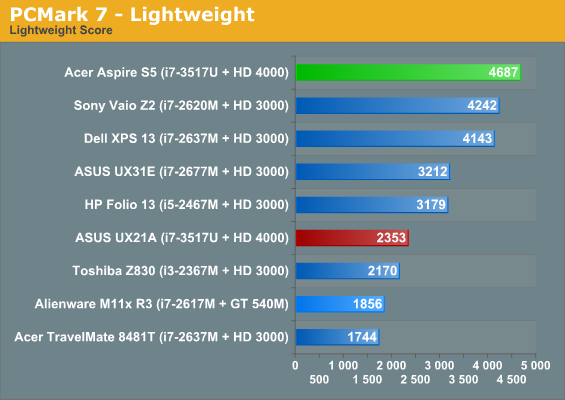
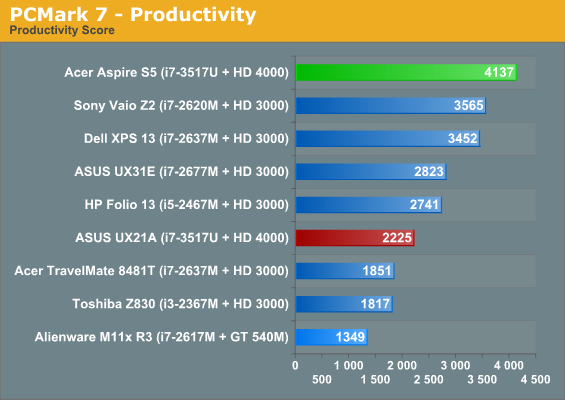
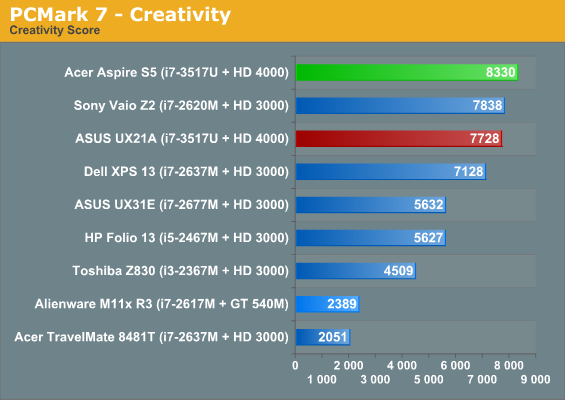
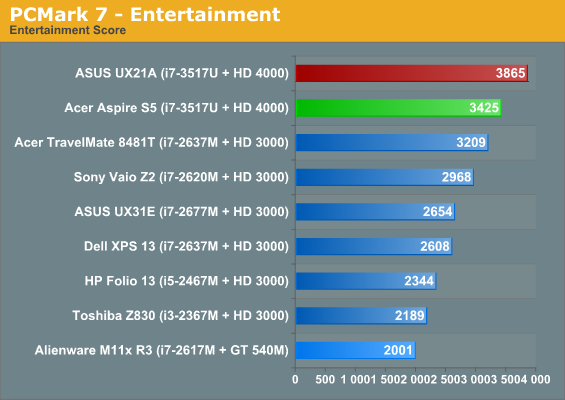
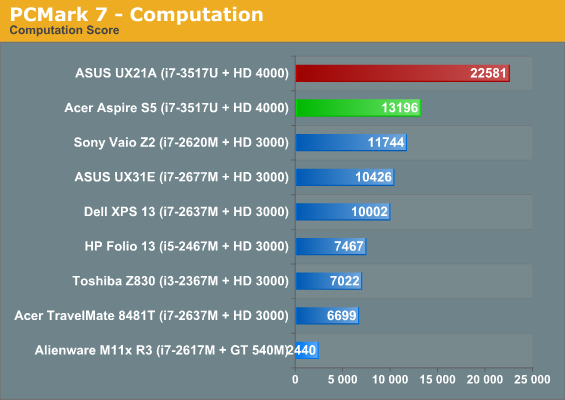
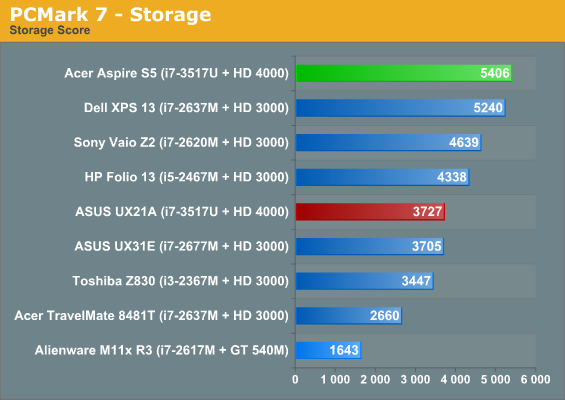
For the most part, the SSD solution in Acer's notebook does indeed seem to be the fastest we've yet tested. That gives it a slight edge against the otherwise comparable ASUS Zenbook Prime UX21A. For reference, even in Microsoft's Performance Advisor, the striped SSD maxes out the score at 7.9.
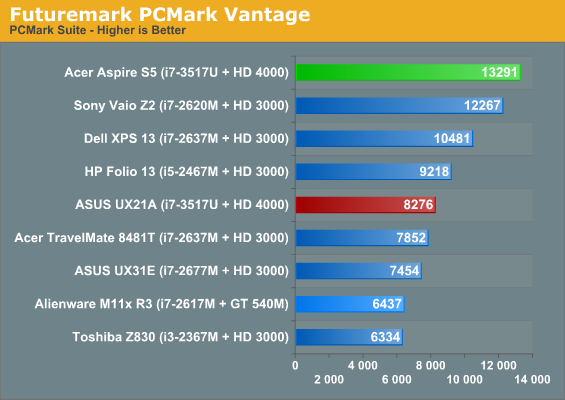
PCMark Vantage tells the same story, favoring faster SSD solutions against virtually anything else.
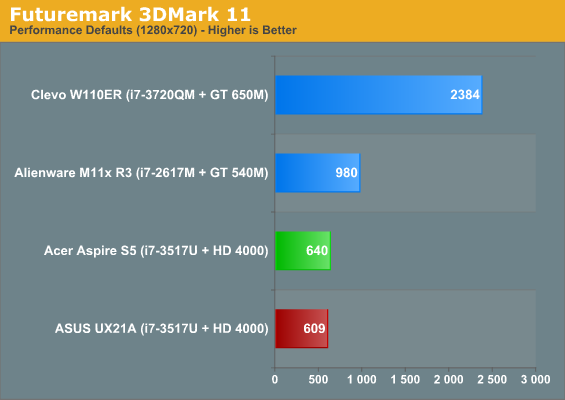
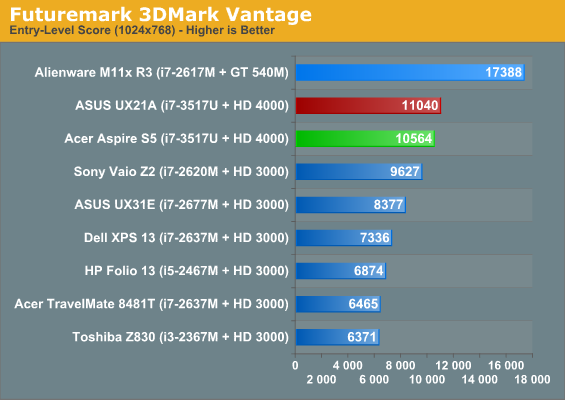

Unfortunately, 3DMark performance remains less than impressive. Pay attention to 3DMarks Vantage and 06 in particular; the faster, standard-voltage CPU in the Sony Vaio Z2 gives the last generation HD 3000 more breathing room and allows it to outperform the otherwise substantially faster HD 4000 graphics core.

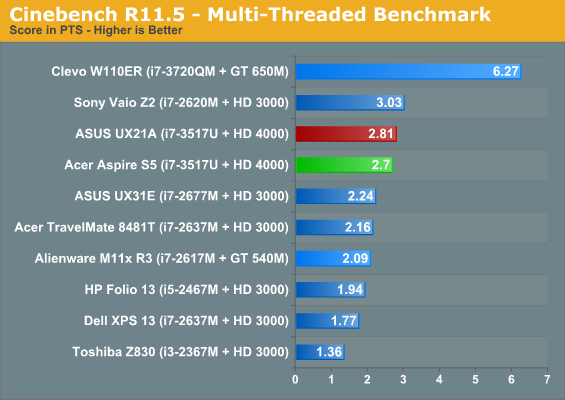
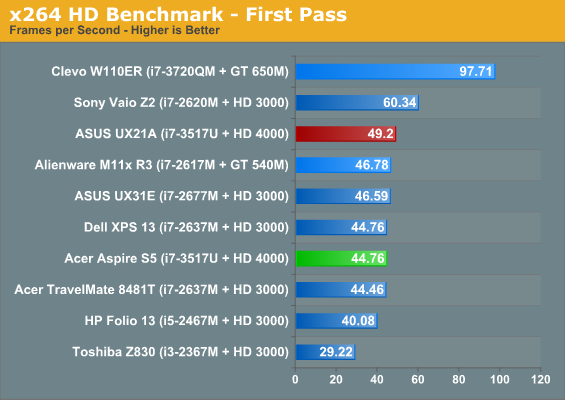
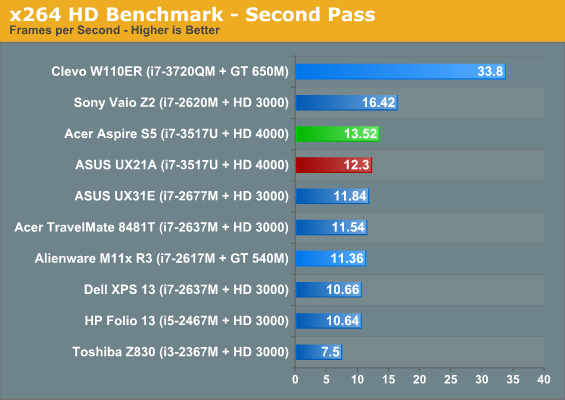
More fundamental CPU performance is about where it ought to be. The S5 and ASUS UX21A tend to trade blows, and I suspect this largely has to do with how each notebook manages its own thermals. For testing, the trap door of the S5 wound up being open the entire time, allowing the S5 to run its processor a little harder.










82 Comments
View All Comments
C'DaleRider - Tuesday, July 10, 2012 - link
With all the complaints about the display in the article.....what'd you expect from Acer? An Apple quality display? Seriously? From the bottom-of-the-barrel PC maker? LOL!jabber - Tuesday, July 10, 2012 - link
Isn't Acer the firm that is telling Microsoft it shouldn't try to get into making tablets and laptops?Well Acer, I don't think they could do any worse could they?
Dug - Tuesday, July 10, 2012 - link
For the price, yes.ThreeDee912 - Thursday, July 12, 2012 - link
Eh, a high-end 13" MacBook Air is $100 more, and although you get a slightly slower CPU, you get a significantly better 1440x900 panel, more battery life, backlit keyboard, built-in SD card reader, and faster 1600MHz DDR3 RAM.And yeah, looks like the review forgot to mention the keyboard isn't backlit, but other sites seem to mention it.
Or for $200 less you can get a low-end 13" Air and still get all that, but with less SSD space.
Only thing you don't get is a built-in HDMI port as Apple's pushing the Mini-DisplayPort/Thunderbolt combo.
nickod - Tuesday, July 10, 2012 - link
Would be good if the laptop tests explicitly said if HDMI and display port displays could be used together.Dustin Sklavos - Tuesday, July 10, 2012 - link
They can.Penti - Wednesday, July 11, 2012 - link
I guess the Thunderbolt supports DisplayPort which at least mean it can output higher resolutions then the HDMI's single-link sub 3GHz 1920x1200. It's a big plus if it actually can drive your 27 or 30-inch monitor, if you have one of those and also won't stop you from getting one. I think it's sad to see just HDMI or VGA on laptops today, Displayport is essential. At least for any serious use. Everybody do not like to be sitting there stuck with 1920x1080 TN-screens.seapeople - Tuesday, July 10, 2012 - link
Why did PC makers "decide" that 4-5 hours of battery life is good enough? They keep pumping tech into laptops, making them thinner and thinner and lighter and lighter... and simultaneously dropping the battery size, taking away one of the potential benefits of such a system. It's not like old boxy 15" laptops got 4-5 hours of battery life because they decided that's the perfect amount of battery life to target, they got 4-5 hours of battery life because that's all they could get using full size components and not have the laptop be as thick as a phone book.Now, we have thin, low power components, and the opportunity to make something like a 20mm thick laptop with 12+ hour battery life, which is still pretty thin, but instead we get a tapered 15mm SUPER THIN laptop that doesn't improve on battery life.
I mean, isn't the entire concept of an ultraportable that you can take it places easily, which would thus make battery life of paramount importance? But no, it's as if PC makers are taking random stabs in the dark to get market share, saying "Look at us, we made a laptop thinner than Apple!" rather than actually putting out laptops that are well built and, most importantly, make sense for the market they're targeting.
mrdude - Wednesday, July 11, 2012 - link
Because Ultrabooks aren't about practicality or performance or even weight but about looks. They're made and marketed as an "Ooooh, look at me!" type of gadget instead of something that makes sense.JarredWalton - Wednesday, July 11, 2012 - link
The thing is, Ultrabooks make sense for a certain market; they're just not for everyone (or, dare I say it, even most people). If you travel a lot and/or are constantly wandering around your work place and you need to take your computer with you, a 3 pound Ultrabook (formerly ultraportable) is very convenient. Assuming you have it set to go into sleep mode when you close the lid, you typically only need around 6 hours of continuous battery life to last all day at the office, not to mention making it through any continental flights.Now if you're on international flights or you want to be able to have your laptop on and doing work for 8-10 hours straight, obviously you need more battery capacity. There are laptops that target that market as well, typically by offering sheet batteries or extended batteries. But while it's possible to build a 3-4 pound laptop that can last 12+ hours on a single charge, such laptops aren't for everyone -- just like the typical Ultrabook. FWIW, I know personally I rarely have need of more than six hours of continuous use battery life.